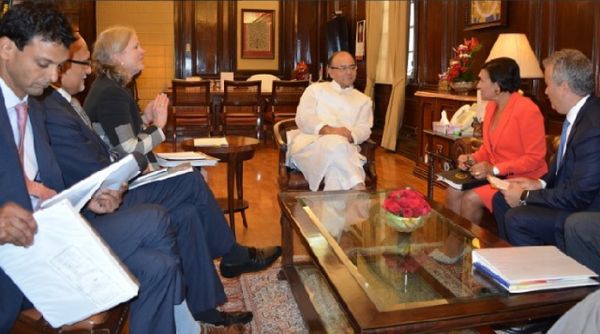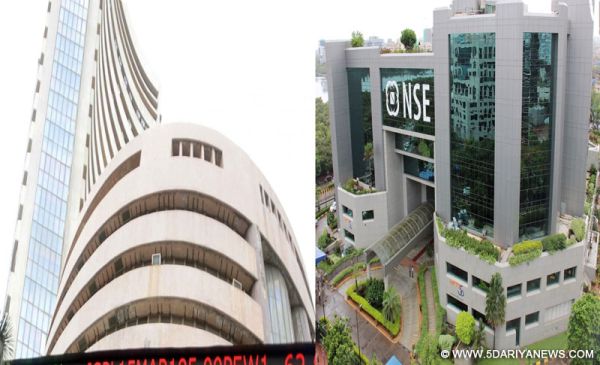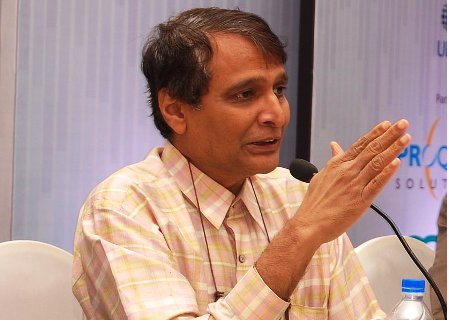
by admin | May 25, 2021 | Economy, News, Politics

Arun Jaitley
New Delhi : Buoyed by recent World Bank figures, Union Finance Minister Arun Jaitley has said India is likely to become the fifth largest economy next year, surpassing Great Britain, if the country continues its projected growth trajectory.
The World Bank has forecast a growth rate of 7.3 per cent for India this year and 7.5 per cent for the next year.
In an article appearing on the BJP website, Jaitley said the recently released World Bank data revealed that India has now become the sixth largest economy relegating France to the seventh position. He acknowledged that there would be a very significant difference in the per capita income of the two countries on account of a disparity in the size of the population.
“If we keep growing at the rate which is being projected, it is likely that next year we will be the fifth largest economy ahead of Great Britain. This is in consonance with the rest of the narrative. Being the fastest growing economy for the last four years, we can look at the next decade as one of economic expansion,” Jaitley said.
He said India has already seen a significant upward movement in its ranking in the ease of doing business and as a preferred investment destination.
“Today we stand to be tested in the midst of a global challenge thrown up on account of the international crude oil prices and the trade war,” he said.
Jaitley said the country has started witnessing many of the advantages of a fast growing economy. He said since Prime Minister Narendra Modi took over, the Government’s own yardstick for performance has become stiffer.
“How quickly we are able to deplete poverty levels of a section of our people poses a major challenge,” he said. The minister said India’s growth story is likely to continue as per assessment of all credible agencies.
—IANS

by admin | May 25, 2021 | Economy, Markets, News
 By Rituraj Baruah,
By Rituraj Baruah,
Mumbai : Growth in the manufacturing sector and a hike in the minimum support prices of Kharif crops supported investor sentiments and lifted the key equity indices in the week ended Friday.
However, escalation in the trade war tensions between the US and China limited the gains on the domestic indices.
Providing a major support to the market, the Nikkei India Manufacturing Purchasing Managers’ Index (PMI), rose to 53.1 in June from 51.2 in May, registering the fastest improvement since December 2017. The data was released on Monday.
Index-wise, the wider Nifty50 of the National Stock Exchange closed the week’s trade at 10,772.65 points — up 58.35 points or 0.54 per cent — from its previous close.
The barometer 30-scrip Sensex of the BSE rose by 234.38 points or 0.66 per cent to close at 35,657.86 points on a weekly basis.
The market breadth was negative in three out of the five trading sessions of the week, said Deepak Jasani, Head of Retail Research at HDFC Securities.
Prateek Jain, Director, Hem Securities said: “Benchmark indices logged modest gains last week as India’s manufacturing conditions improved in June 2018 at the strongest pace since December 2017 boosted sentiment.”
According to Equity99’s Senior Research Analyst, Rahul Sharma: “Auto and consumer stocks were in demand throughout the week after the Union Cabinet approved a hike in minimum support prices for Kharif crops by 1.5 times of the input cost for the 2018-19 season. This is likely to have a positive effect on the overall economy.”
Jain, however added, gains were capped by the escalating trade war between the US and China.
Further, he said, the Indian rupee weakened during the week to touch a fresh closing low of 68.95 on Thursday, amid fears over a slowdown in the economy which affected the trading sentiments.
On a weekly basis, rupee closed at 68.88, weaker by 41 paise from its previous week’s close of 68.47 per greenback.
In terms of investments, provisional figures from the stock exchanges showed that foreign institutional investors sold scrip worth Rs 2,455.44 crore, while the domestic institutional investors purchased stocks worth Rs 2,073.70 crore during the July 3-6 period.
Figures from the National Securities Depository (NSDL) revealed that foreign portfolio investors (FPIs) divested Rs 2,737.04 crore, or $398.62 million from the equities segment on stock exchanges during the week ended on July 6.
Sector-wise, auto and FMCG were the major gainers and those ending in the negative include metals, infrastructure and realty, Jasani told IANS.
The top weekly Sensex gainers were Bajaj Auto (up 7.55 per cent at Rs 3,023.35); Maruti Suzuki (up 5.48 per cent at Rs 9,304.80); Hero MotoCorp (up 4.74 per cent at Rs 3,636.70); Asian Paints (up 4.64 per cent at Rs 1322.80); and Yes Bank (up 3.77 per cent at Rs 352.40 per share).
The major losers were Vedanta (down 6.89 per cent at Rs 219.50); NTPC (down 5.77 per cent at Rs 150.25); Bharti Airtel (down 5.03 per cent at Rs 361.85); Power Grid (down 2.89 per cent at Rs 181.25); and Tata Steel (down 2.41 per cent at Rs 554.15 per share).
(Rituraj Baruah can be contacted at rituraj.b@ians.in)
—IANS

by admin | May 25, 2021 | Business Ideas, Economy, Entrepreneurship, News, Politics, Startup Basics, Your Business Plan

Suresh Prabhu
Kolkata : New India should have an economy driven by entrepreneurship and innovation, Union Commerce and Industries Minister Suresh Prabhu said here on Saturday, cautioning that the debate between public and private sectors should be judged solely by national interest and not by ideological considerations.
“In new India, we must make sure India should be the dominant economy of the world, India must be a model economy of the world, it must have a model industry… India must have an economy driven by entrepreneurship and innovation,” Prabhu said here.
Addressing students of National University of Juridical Sciences, the Union Minister said one needs to find out whether the public or the private sector or both together best serve India’s interests in a given field, time and situation.
“We should not just be swayed by ideology. We should not say public sector will solve all the problems nor should we say public sector will not exist. We must find out what is good for India. And that what is good for India will change from time to time,” Prabhu said speaking on the topic “Privatising Public sector: The Lessons Learnt and Way Ahead”.
Turning to 1956, when Parliament passed the Industrial Policy Resolution that stressed on state control of the economy, Prabhu said: “There is no point in now saying whether it was right or wrong. May be it was right. But just because it was right in 1956, one should not assume it will be right in 2018.
“We have to keep evaluating the situation, and take right decisions. Future of public sector is not as important as future of India. What is important is future of India,” he said.
He said in a changing world, one needs to be flexible with ideas about the development of the country.
“What is necessary for India will keep on changing because the world is changing. So if we just take one idea and say we won’t look at any other idea as our idea is the best, that will be akin to an ostrich mentality.”
Without naming any country, he said the nations which did not change with time were now struggling, “trying to come out of the shell, and make new friends, just to integrate into the new economy”.
—IANS

by admin | May 25, 2021 | Corporate, Corporate Governance, Economy, Finance, Markets, News, Politics
 New Delhi : The government on Tuesday declared its intent to change the base year for calculation of GDP and retail inflation to 2017-18 and 2018 respectively, likely to come to effect by fiscal 2019-20.
New Delhi : The government on Tuesday declared its intent to change the base year for calculation of GDP and retail inflation to 2017-18 and 2018 respectively, likely to come to effect by fiscal 2019-20.
The previous base year revision for gross domestic product (GDP), the index of industrial production (IIP) and the consumer price index (CPI), or retail inflation was revised to 2011-12 and 2012, respectively, Statistics and Programme Implementation Minister Sadananda Gowda told reporters here while briefing about the ministry’s achievments in the last four years.
“The revisions facilitated more accurate assessment of the progress of the economy and the society. Steps are being initiated for the next round of revision also, for GDP we would like to revise the base year to 2017-18 and base year for consumer retail inflation to 2018,” he said.
“These principles are aimed at promoting good practices and professional ethics in production and dissemination of official statistics,” he added.
—IANS

by admin | May 25, 2021 | Opinions
 By Amit Kapoor,
By Amit Kapoor,
Are most nations able to keep up economic progress while ensuring improved standards of living for their citizens? Or vice-versa? Are all productive nations prosperous? The answer is No.
Even an advanced nation such as the US, which ranks second in the Global Competitiveness Report 2017, gets no mention in the top 10 countries in terms of social progress. On the other hand, a nation with “very high social progress” such as Iceland, barely makes it to the top 20 competitive economies of the world. Even a booming economy like China, which is ranked high in terms of competitiveness, fails to assure that its citizens are also able to reap the fruits of increasing competitiveness.
The bitter truth is that most nations are unable to manage a balance between competitiveness and social progress — though both are essential to create a prosperous nation. Prosperity arises out of successful competitiveness, which is a combination of two key factors: Achievement of productivity and economic progress, which we call competitiveness; and secondly, ensuring that the benefits of the improved competitiveness percolates to the citizens, which we call social progress. Unless and until citizens reap the benefits of the higher productivity and improved competitiveness, the nation will not be able to become prosperous.
The question is: Where does India stand?
The World Bank recently predicted that India will be the fastest-growing economy in 2018-19 with a growth rate of 7.3 per cent, and there is hope is that it will only move upwards in the coming two years. And, currently, it stands at the 40th position globally in competitiveness. The Indian gross value added (GVA) has the largest contribution coming from the service sector, which has a sectoral GVA of 8.3, followed by GVA of 7.7 of industry, and 2.1 for agriculture and allied activities, based on the advanced estimates of 2017-18.
Can we assume that a flourishing economy will ensure a prosperous India? Not quite. Currently, India is at a poor social progress standing of 98th position globally, much behind Asian countries like Japan, and even South Asian neighbours like Sri Lanka and Nepal. It has an infant mortality rate of 37 per 1,000 live births, and 21.92 per cent of the population continues to remain below the poverty level. Even though there remains a positive relationship between competitiveness and social progress, India needs to deal with the pinching issues of poor standards of living for its citizens.
As Michael Porter says, “building prosperity is a marathon”, wherein it takes long to raise competitiveness levels and even longer to ensure the benefits of the increased productivity reach citizens.
No doubt India is facing an uphill task. Then, how do we make a prosperous nation?
India is showing potential of increased competitiveness lately, but the key to prosperity lies not just in economic progress, but in sustenance of the same, complemented by an increased standard of living for the citizens. On one hand, India needs pick up pace at being an innovative economy, and let innovation and clusters drive it to a point of sustainable economic progress. Currently, online application for patents and trademarks has increased by 90 per cent and 80 per cent, respectively.
The wheels of progress are already in motion for clusters as conducive environments are being created for the IT sector, especially in Bengaluru. There are also talks about creating favourable business environment to create Artificial Intelligence clusters in Maharashtra and cyber-security clusters in Hyderabad. The fusion of two growth-enabling factors is going to make India a sustainable competitive economy.
On the other hand, the businesses need to create value for the citizens of the nation and ensure that such innovation is not restricted to just the productive sectors, but to facets of health, education, water and sanitation, as well as a struggling agriculture sector, which seems to be a missing piece in the Indian scenario.
Sustainable economic progress and robust social progress go hand-in-hand, and India can create this prosperity by learning from the best, especially Nordic countries like Switzerland and Sweden. These nations are among the few that ace the game in social as well as economic progress, as their relative standing remains in the top 10 for both. Creation of an innovative economy has also allowed these nations to reap the joys of being prosperous nations.
The pathway to prosperity lies in India’s capacity to reach higher economic progress, sustain it and ensure higher standards of living of its citizens, wherein the driving force must be innovation. So, the need of the hour is to create an innovation-economy which drives the economy and reaches the citizens of the country!
(Amit Kapoor is chair, Institute for Competitiveness, India. He can be contacted at amit.kapoor@competitiveness.in and tweets @kautiliya. Paramjeet Chawla, senior researcher, Institute for Competitiveness, India has contributed to the article).
—IANS





